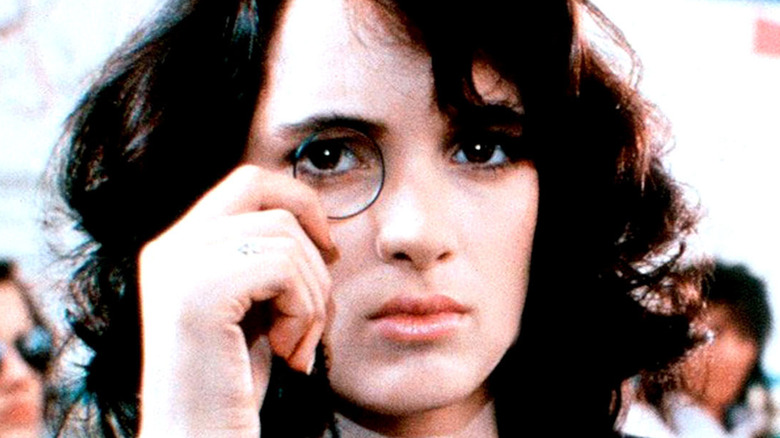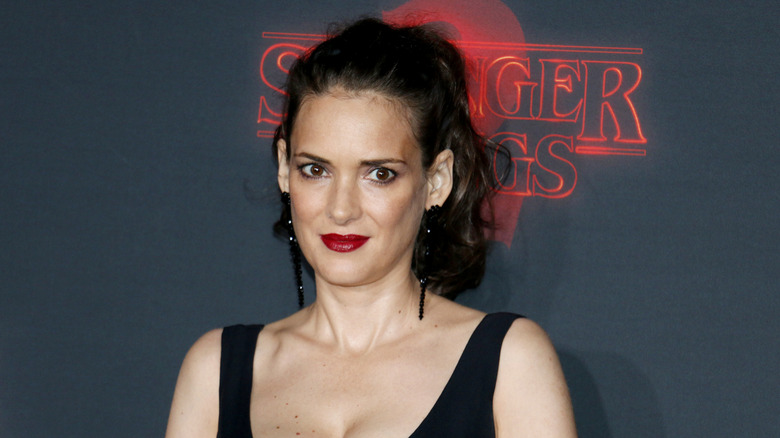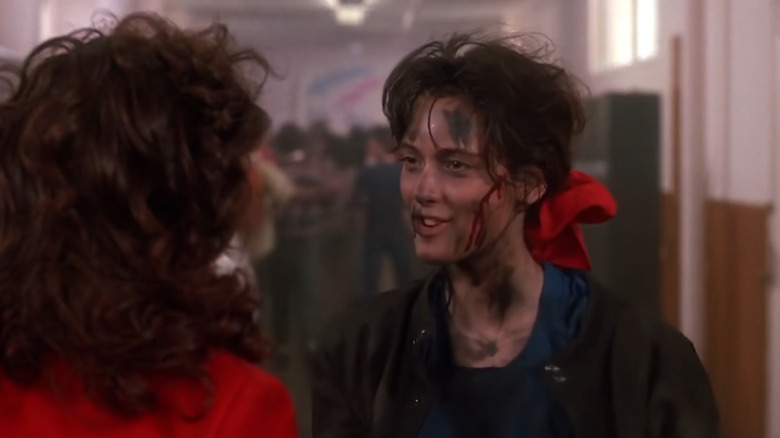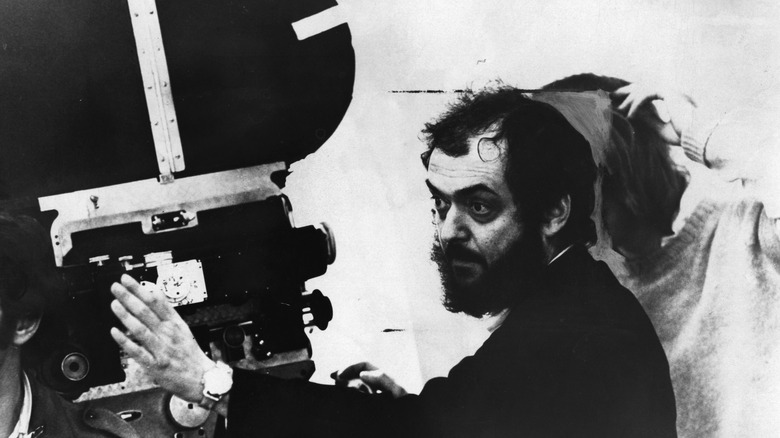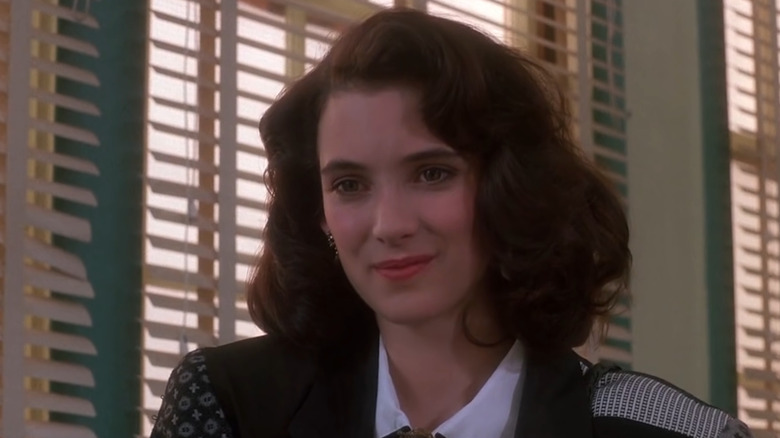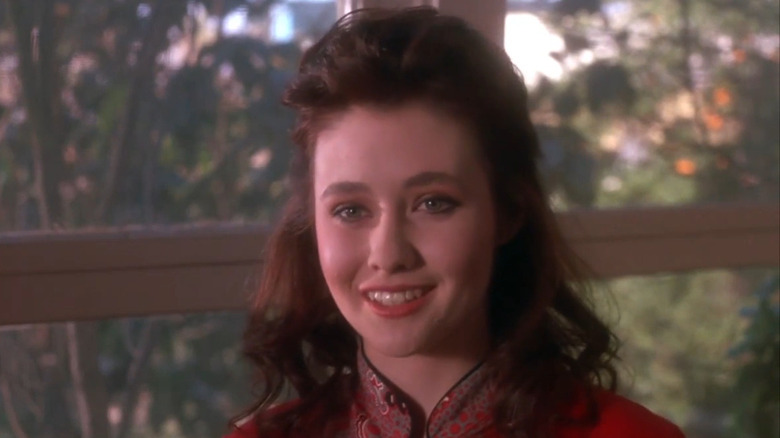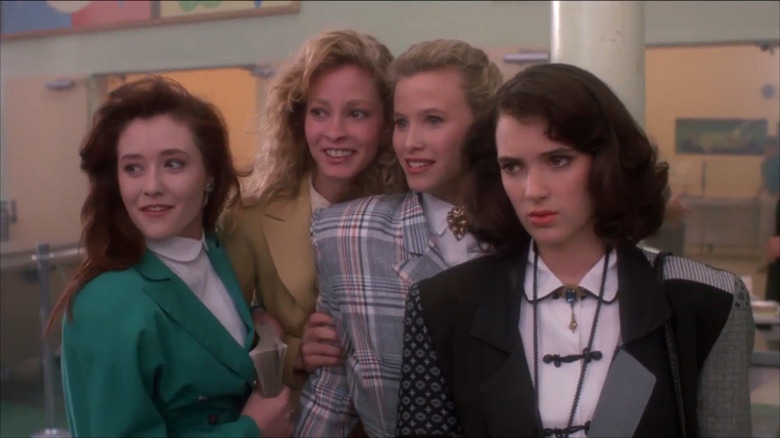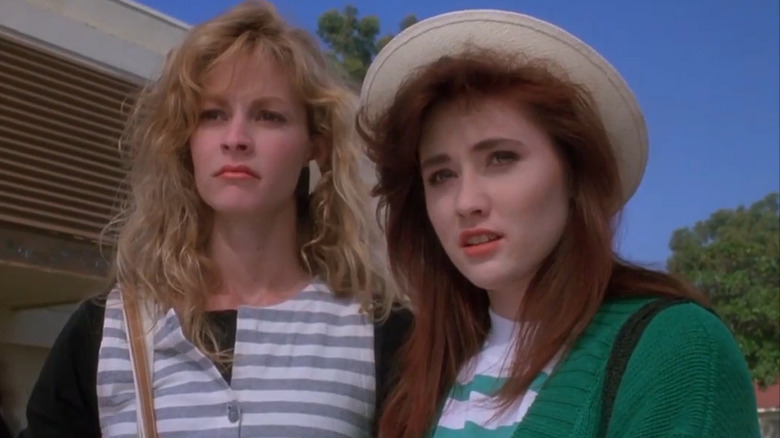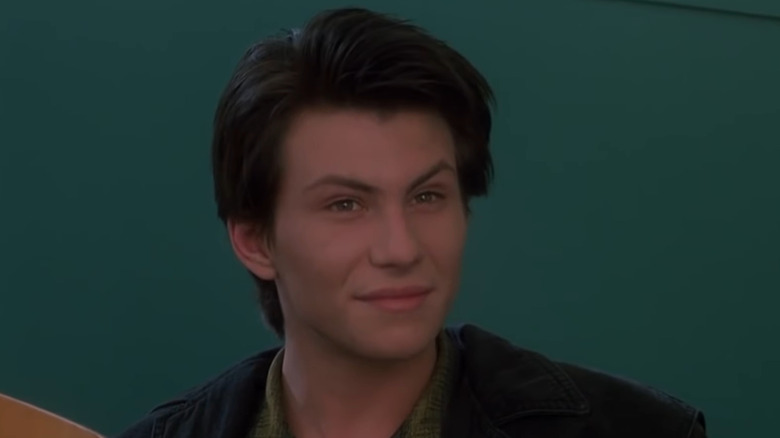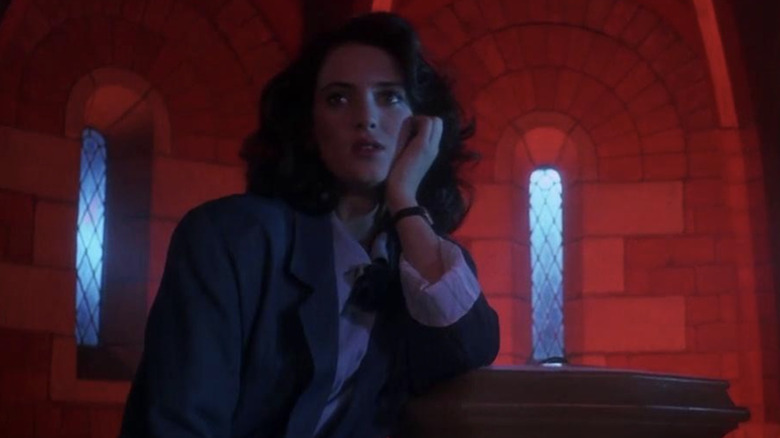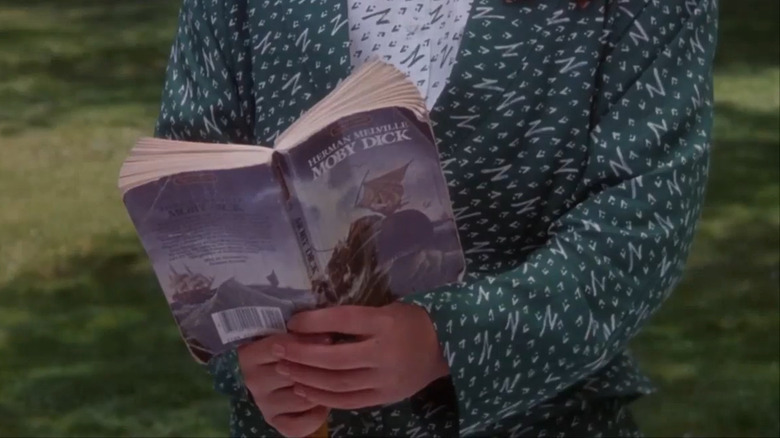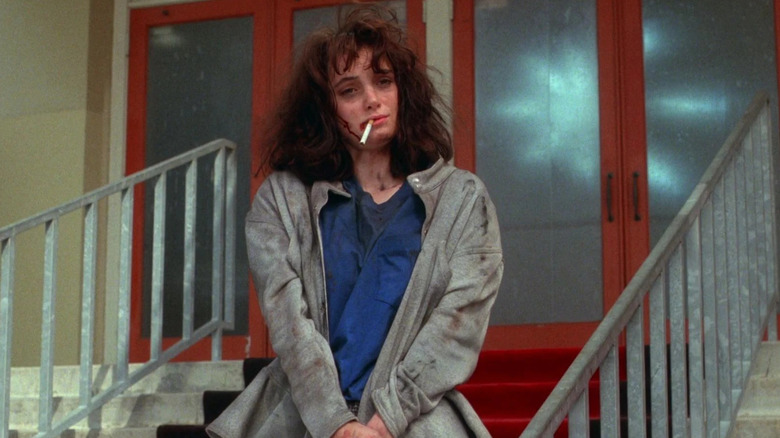The Untold Truth Of Heathers
While 2004's "Mean Girls" may arguably be the most quotable teen movie of all time, the 1989 dark comedy "Heathers" gives it a run for its money. In fact, without the witty, cynical masterpiece that is "Heathers," it's hard to imagine a film like "Mean Girls" even existing. The connection is more than thematic too – "Heathers" scribe Daniel Waters is the older brother of "Mean Girls" director Mark Waters.
"Heathers" follows Veronica (Winona Ryder), a member of the most popular clique at her high school. She's tired of her mean friends — all of whom are named Heather — and becomes intrigued by the antics of rebellious outsider J.D. (Christian Slater), who she soon begins dating. What follows is a deadly standoff between J.D. and the popular kids, with Veronica caught in the middle, as the body count grows.
"Heathers" is a teen comedy with a pitch black heart, and its popularity has only grown since its initial theatrical run, as many recognize it as one of the best teen movies of all time. Released during a period when earnest, light-hearted John Hughes movies were all the rage, "Heathers" stands out as an example of a film that takes teenagers at their word, even when their word is demented and murderous. One of Winona Ryder's breakout roles, it remains an iconic representation of emo teenage girls everywhere, an image that would go on to define Ryder's career.
A cult classic and an unlikely critical success, it's not surprising that the story behind "Heathers" is just as compelling as the film itself. If you're interested in the behind-the-scenes secrets of this beloved teen film, then keep reading to discover the untold truth of "Heathers."
Winona Ryder wanted to star in a sequel
"Heathers" was not a huge box office hit upon its initial release, but Winona Ryder was a strong believer in the film's brilliance. In fact, she loved the move so much that she spent months lobbying for a sequel. In an interview with Paul Rowlands, "Heathers" writer Daniel Waters said that Ryder started pressuring him about making a sequel right after the film came out. So, he came up with an idea for a sequel which involved "Veronica being a page working for a Senator played by Meryl Streep and having to kill the President by the end of the story."
Ryder took Waters' idea seriously. "I remember that a year later Winona came up to me and said 'I talked to Meryl and she's in,'" Waters said. But alas, a sequel just wasn't in the cards. "Even that wasn't enough to make me want to write it," Waters admitted.
While there has never been an actual sequel to "Heathers," there have been a few adaptations. "Heathers: The Musical" premiered in 2010, and a short-lived, poorly received "Heathers" television show aired in 2018. Neither of these adaptations make up for the sequel that never was, but we hope Ryder remains proud of her contribution to society nonetheless.
The original ending was much darker
"Heathers" is a very dark movie — what, with the murdering and all — but it was initially going to be much darker. In Daniel Waters' original script, "J.D. blew up the high school and they all died, then there was a prom scene in heaven," director Michael Lehmann told Entertainment Weekly. New World Pictures, the production company financing the film, had already given the filmmakers the go-ahead, but then they balked at such a dark ending. According to Lehman, New World's response was, "No way. We can't make a satirical movie about teenage suicide in which the people actually kill themselves."
Speaking with Vice, Waters joked that while people often tell him "Heathers" couldn't have been made today, it almost wasn't made back then either. Waters and Lehmann weren't happy with the decision to change the ending at first, but they eventually came around to the idea. Nonetheless, Lehmann told Vice that still wishes the original ending — with all of its dark irony — could have come to fruition.
For her part, producer Denise Di Novi thinks the ending they went with was the right choice. "Even though the movie is dark, there is a beating heart," Di Novi told Marie Claire. "Veronica is basically a good person, so the darker alternate endings didn't really make sense." Whether or not the ending they chose is the "right" ending is clearly up for interpretation, which is perhaps part of the film's enduring appeal.
If you or anyone you know is having suicidal thoughts, please call the National Suicide Prevention Lifeline by dialing 988 or by calling 1-800-273-TALK (8255).
The writer wanted Stanely Kubrick to direct the film
"Heathers" scribe Daniel Waters began writing the script for the film in the spring of 1986, while he was working at a video store. In an interview with Paul Rowlands, he noted that his biggest inspirations for the story were the satirical tone of Stanley Kubrick's "Dr. Strangelove" and the narration of Terrence Malick's "Badlands," two elements he wanted to combine in his own film. Being young and hopeful at the time, Waters' idea was that Kubrick would be the one to direct the film.
When Rowlands asked Waters if he actually thought that was a realistic goal back then, he responded in the affirmative. "I honestly did think that somehow he would see the script and say 'Yeah, I'll do it,'" Waters recalled. "I thought I would have to go to England and work with him, and he would probably take a screenwriting credit with me," he went on. "That was me being realistic!"
Kubrick did not end up directing "Heathers," of course — that job went to Michael Lehmann — but his influence on the film remained. The iconic opening cafeteria scene in the film was actually an homage to the scene in the barracks from Kubrick's "Full Metal Jacket," according to the "Heathers" DVD commentary (via Entertainment Weekly).
Winona Ryder wasn't the first choice for Veronica
As is the case for most Hollywood films, the casting process for "Heathers" was far from simple. According to Entertainment Weekly, the first names on the list for Veronica were Jennifer Connelly and Justine Bateman, but both actresses turned down the role. Waters told Vice that Connelly — his first pick — had to say no because her parents disapproved of the script.
Ryder was next on the list, but Waters didn't think she was attractive enough for the role. "You have to understand, at the time, I didn't look that different from my character in Beetlejuice," Ryder explained to Entertainment Weekly. In order to convince producers she was right for the role, she went to the mall and got a full makeover.
For the role of Heather Chandler, director Michael Lehmann wanted Heather Graham, but her parents also wouldn't let her do it because of the dark nature of the film. Instead, they cast Christian Slater's then-girlfriend, Kim Walker, in the part. Shannen Doherty read for Heather Duke, though Lehmann maintains she really wanted the role of Veronica. Doherty said she doesn't remember it that way since Ryder had already been cast when she went in to read, but she does recall refusing to go blonde because it would have ruined her hair, so they settled on red instead.
Shannen Doherty wasn't too happy about the film's foul language
Several potential cast members — like Heather Graham and Jennifer Connelly — weren't able to take the part because their parents balked at the film's explicit content, so it's not all that surprising that this created a few problems on set as well. The script was especially challenging for Shannen Doherty, who had a conservative upbringing and wasn't always comfortable with the film's obscenity.
Speaking with Entertainment Weekly, Ryder recalled a moment when Doherty wouldn't say what is now one of the film's most iconic lines. "She was supposed to say, 'F*** me gently with a chain saw.' But she refused to say it," Ryder remembered. Doherty explained why a lot of the dialogue was difficult for her: "It was definitely the first time I had ever, ever spoken like that in my entire life. I was a very sheltered 17-year-old," she said.
Interestingly enough, Doherty's discomfort with the script may have actually worked in the film's favor. As producer Denise Di Novi put it, "I don't think [Shannen] at the time quite got what Heathers was, and that actually worked for us. She made that character real." Doherty admitted that when she first saw the film, she ran out crying because she didn't realize it was a comedy and was worried about how people would take it. However, when she watched it again later, she realized that it was "really good and cutting-edge."
Most of the actors in the film were teenagers themselves
If there's one thing "Heathers" director Michael Lehmann has always found annoying, it's the fact that high schoolers in movies are usually played by full-grown adults. Remembering his frustration about this age disparity in the 1980s, Lehmann told i-D, "I couldn't understand why most of the popular teen movies of the time didn't have teenagers in them!"
So, Lehmann made sure that this wasn't the case with "Heathers" — almost all of the actors in the film were under 20. Christian Slater was 19 at the time, Shannen Doherty was 17, and Winona Ryder was actually 15 when they started filming and turned 16 during production. While this made the characters feel more believable, Lehmann believes that it also made the film even darker. "There's something particularly disturbing about seeing something as hard-edged as Heathers being played by actual teenagers," he explained.
The only outlier was Lisanne Falk, who played Heather McNamara. She told Entertainment Weekly that she had lied about her age in the audition, wanting to seem closer to the ages of the other actors. One night at dinner with the cast and crew, she mentioned that she was living with her boyfriend down the street, and producers wondered if her mother was okay with that. Falk revealed the truth: "I'm like, 'You guys know I'm 23, right?' ... And they all were like, [gasps]! I could just see the panic."
The film's dialogue was meant to be memorable
"Heathers" is chock-full of memorable lines that have stood the test of time. If you've ever told someone to "lick it up" or asked "what's your damage," you can thank screenwriter Daniel Waters. The dialogue in the film has a very unique style, and it's part of what makes the film stand out. Waters told Vice that this was very intentional. "We committed to a certain stylization, and everyone talks in a certain rhythm, and I think it works," he said.
Waters took a different approach than other screenwriters in creating the dialogue of his high school characters. Rather than doing research in high schools and creating a catalog of the slang contemporary teenagers used, Waters wanted to create something completely new. "I wanted a certain timelessness, and I could guarantee that by coming up with my own slang," he explained. Like "Mean Girls," which in many ways is a successor to "Heathers," the dialogue and catchphrases in the film are strange enough that they stick in the minds of viewers. Waters' strategy was clearly a success, as the slang from the film is still referenced today. In the words of Veronica, "how very."
Christian Slater was channeling Jack Nicholson in the film
Christian Slater's J.D. is a classic bad boy character. He smokes, wears a long trench coat, and scoffs at the frivolousness of his fellow teens. In fact, J.D. is so disgusted with the trivial lives of his classmates that he begins killing them by staging their suicides and ropes Veronica into his devious schemes.
While J.D. clearly sees himself as the truth-teller at Westerburg High, it's obvious he's posturing just as much as his classmates. No one comes up with a persona like that without a little practice. As it turns out, Slater also learned from one of the great bad boys of cinema in order to create the iconic character.
If J.D.'s movements and speech patterns seem a little familiar to you, that's because Slater was trying to imitate an A-list star. Slater admitted to Yahoo! News that he had been watching a lot of Jack Nicholson films prior to shooting "Heathers," so the actor was on his mind. "I can't deny it. It was certainly a very conscious channeling," he said.
Slater went on to say that he was a young actor who was still looking for his identity, which is why he attached himself to an acting great like Nicholson. "I was obsessed and impressionable and loved his work and performances in all of those movies and was such a fan, and was just absorbing a lot of what I saw in the movies," Slater explained. He said he's more confident in his identity and who he is as an actor today, but back in the '80s, it was Nicholson all the way.
Wynona Ryder offered to do the movie for free
"Heathers" has amassed a passionate fan base over the years, but few love the movie as much as its star, Winona Ryder. Speaking with Interview Magazine, Ryder explained how she was obsessed with the script after she first read it. She even called director Michael Lehmann and told him, "You don't have to pay me. I just want to say these lines." Although "Heathers" didn't do very well at the box office, Ryder maintains that it opened up many opportunities for her in Hollywood.
While Ryder may have immediately been enamored by the script, not everyone thought the movie was the right fit. Speaking with Entertainment Weekly, she explained, "My agent at the time literally got on her knees and begged me not to do [the movie]. She had her hands together, and she goes, 'You will never. Work. Again.'" We all know how that turned out, of course, as "Heathers" remains one of Ryder's most beloved roles. Her agent didn't last long after that, Ryder admitted.
Ryder is still a huge fan of the film to this day. "If it's on TV, I watch it. I've probably seen it 50 times. Like, I can do it by heart," she told EW. She went on to say that she talks about the movie like a fan, rather than its star. She clearly made the right choice by taking on the role — paycheck or not — and we imagine her former agent probably regrets that particular piece of advice.
Catcher in the Rye was supposed to be featured in the film
"Heathers" is a very smart movie filled with biting pop cultural references and social commentary. One of the most frequent references in the film is Herman Melville's "Moby Dick," which Heather Duke (Shannen Doherty) is seen reading several times throughout. J.D. even attempts to use Heather's copy of the book in order to plan her suicide by underlining choice lines — memorably, the word "Eskimo" — in order to tell an interesting story. J.D. also uses the story of "Moby Dick" — Ahab being the captain of the ship and all – to convince Heather Duke that the school needs a new captain in Heather Chandler's absence.
"Moby Dick" may be the book they got, but it's not actually the book that was supposed to be in the film. As Daniel Waters explained in the film's DVD commentary, the book in the script was actually J.D. Salinger's "Catcher in the Rye," but they weren't able to secure the rights for it (via Film School Rejects). Waters maintained that the film makes a lot more sense when you think of it through the lens of "Catcher in the Rye" instead of "Moby Dick."
We see where Waters was going with this one. While "Moby Dick" is about a man and his white whale, "Catcher in the Rye" is often seen as the ultimate novel of teenage angst and alienation, and it lobs a pretty powerful critique at the superficiality of society. Sound familiar? Slater's character is also named J.D., just like Salinger himself.
Ryder was obsessed with the final cigarette scene
There are many iconic moments throughout "Heathers," but one of the most memorable images comes near the end of the film. After saving the entire school from a bomb that J.D. placed under the auditorium, Veronica is confronted by her deranged ex in front of the school. Instead of blowing up everyone else, J.D. settles on just blowing up himself. Anticipating his fiery demise, Veronica puts a cigarette between her lips. When J.D. finally explodes, Veronica calmly smokes her now-lit cigarette while covered in J.D.'s ashes.
According to producer Denise Di Novi, this scene was one of Winona Ryder's favorites. "Winona was so exited about that—she never smoked, she was just a kid, and she just thought, 'Ugh, I'm gonna look so cool with all the burnt stuff and the cigarette,'" Di Novi told Marie Claire. Ryder "wanted to get it perfect," Di Novi explained, which meant they had to do a handful of takes in order to get a take Ryder was proud of. Ryder was right, of course, as Veronica does look extremely cool smoking that cigarette and covered in "burnt stuff." Never doubt the instincts of a cool teenage girl.
